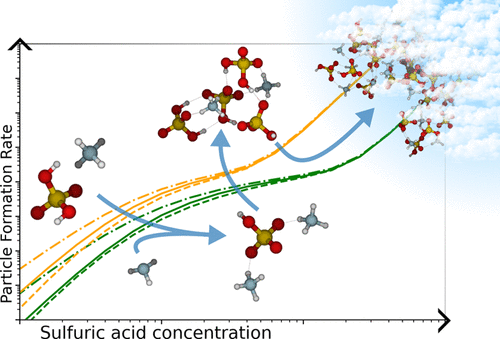当前位置:
X-MOL 学术
›
J. Phys. Chem. A
›
论文详情
Our official English website, www.x-mol.net, welcomes your feedback! (Note: you will need to create a separate account there.)
Impact of Quantum Chemistry Parameter Choices and Cluster Distribution Model Settings on Modeled Atmospheric Particle Formation Rates.
The Journal of Physical Chemistry A ( IF 2.9 ) Pub Date : 2020-06-22 , DOI: 10.1021/acs.jpca.0c03984 Vitus Besel 1 , Jakub Kubečka 1 , Theo Kurtén 2 , Hanna Vehkamäki 1
The Journal of Physical Chemistry A ( IF 2.9 ) Pub Date : 2020-06-22 , DOI: 10.1021/acs.jpca.0c03984 Vitus Besel 1 , Jakub Kubečka 1 , Theo Kurtén 2 , Hanna Vehkamäki 1
Affiliation

|
We tested the influence of various parameters on the new particle formation rate predicted for the sulfuric acid–ammonia system using quantum chemistry and cluster distribution dynamics simulations, in our case, Atmospheric Cluster Dynamics Code (ACDC). We found that consistent consideration of the rotational symmetry number of monomers (sulfuric acid and ammonia molecules, and bisulfate and ammonium ions) leads to a significant rise in the predicted particle formation rate, whereas inclusion of the rotational symmetry number of the clusters only changes the results slightly, and only in conditions where charged clusters dominate the particle formation rate. This is because most of the clusters stable enough to participate in new particle formation have a rotational symmetry number of 1, and few exceptions to this rule are positively charged clusters. In contrast, the application of the quasi-harmonic correction for low-frequency vibrational modes tends to generally decrease predicted new particle formation rates and also significantly alters the slope of the formation rate curve plotted against the sulfuric acid concentration, which is a typical convention in atmospheric aerosol science. The impact of the maximum size of the clusters explicitly included in the simulations depends on the simulated conditions. The errors arising from a limited set of clusters are higher for higher evaporation rates, and thus tend to increase with temperature. Similarly, the errors tend to be higher for lower vapor concentrations. The boundary conditions for outgrowing clusters (that are counted as formed particles) have only a small influence on the results, provided that the definition is chemically reasonable and that the set of simulated clusters is sufficiently large. A comparison with data from the Cosmics Leaving OUtdoor Droplets (CLOUD) chamber and a cluster distribution dynamics model using older quantum chemistry input data shows improved agreement when using our new input data and the proposed combination of symmetry and quasi-harmonic corrections.
中文翻译:

量子化学参数选择和团簇分布模型设置对模拟大气颗粒形成速率的影响。
我们使用量子化学和团簇分布动力学模拟(在本例中为“大气团簇动力学代码”(ACDC)),测试了各种参数对硫酸氨系统预测的新颗粒形成速率的影响。我们发现,一致考虑单体(硫酸和氨分子以及硫酸氢根和铵离子)的旋转对称数会导致预测的颗粒形成速率显着提高,而包含簇的旋转对称数只会改变仅在带电团簇支配颗粒形成速率的条件下才会产生这种现象。这是因为大多数足够稳定以参与新粒子形成的团簇的旋转对称数为1,该规则很少有带正电的簇。相反,准谐波校正在低频振动模式中的应用通常会降低预测的新颗粒形成速率,并且还会显着改变相对于硫酸浓度绘制的形成速率曲线的斜率,这是典型的惯例。大气气溶胶科学。明确包含在模拟中的群集的最大大小的影响取决于模拟条件。对于较高的蒸发速率,由有限的簇集引起的误差会更高,因此会随着温度的升高而增加。同样,对于较低的蒸汽浓度,误差往往会更高。只要定义在化学上是合理的并且模拟簇的集合足够大,向外生长的簇的边界条件(被视为形成的粒子)对结果的影响很小。与使用旧的量子化学输入数据的宇宙离开室外液滴(CLOUD)室的数据和簇分布动力学模型进行的比较显示,当使用我们的新输入数据以及对称和准谐波校正的拟议组合时,一致性得到改善。
更新日期:2020-07-16
中文翻译:

量子化学参数选择和团簇分布模型设置对模拟大气颗粒形成速率的影响。
我们使用量子化学和团簇分布动力学模拟(在本例中为“大气团簇动力学代码”(ACDC)),测试了各种参数对硫酸氨系统预测的新颗粒形成速率的影响。我们发现,一致考虑单体(硫酸和氨分子以及硫酸氢根和铵离子)的旋转对称数会导致预测的颗粒形成速率显着提高,而包含簇的旋转对称数只会改变仅在带电团簇支配颗粒形成速率的条件下才会产生这种现象。这是因为大多数足够稳定以参与新粒子形成的团簇的旋转对称数为1,该规则很少有带正电的簇。相反,准谐波校正在低频振动模式中的应用通常会降低预测的新颗粒形成速率,并且还会显着改变相对于硫酸浓度绘制的形成速率曲线的斜率,这是典型的惯例。大气气溶胶科学。明确包含在模拟中的群集的最大大小的影响取决于模拟条件。对于较高的蒸发速率,由有限的簇集引起的误差会更高,因此会随着温度的升高而增加。同样,对于较低的蒸汽浓度,误差往往会更高。只要定义在化学上是合理的并且模拟簇的集合足够大,向外生长的簇的边界条件(被视为形成的粒子)对结果的影响很小。与使用旧的量子化学输入数据的宇宙离开室外液滴(CLOUD)室的数据和簇分布动力学模型进行的比较显示,当使用我们的新输入数据以及对称和准谐波校正的拟议组合时,一致性得到改善。



























 京公网安备 11010802027423号
京公网安备 11010802027423号